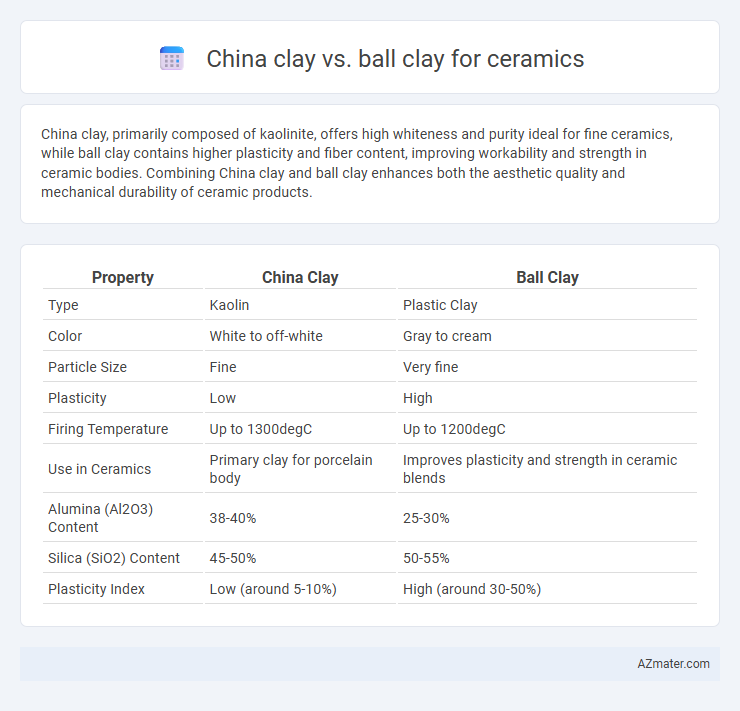China clay, primarily composed of kaolinite, offers high whiteness and purity ideal for fine ceramics, while ball clay contains higher plasticity and fiber content, improving workability and strength in ceramic bodies. Combining China clay and ball clay enhances both the aesthetic quality and mechanical durability of ceramic products.
Table of Comparison
| Property | China Clay | Ball Clay |
|---|---|---|
| Type | Kaolin | Plastic Clay |
| Color | White to off-white | Gray to cream |
| Particle Size | Fine | Very fine |
| Plasticity | Low | High |
| Firing Temperature | Up to 1300degC | Up to 1200degC |
| Use in Ceramics | Primary clay for porcelain body | Improves plasticity and strength in ceramic blends |
| Alumina (Al2O3) Content | 38-40% | 25-30% |
| Silica (SiO2) Content | 45-50% | 50-55% |
| Plasticity Index | Low (around 5-10%) | High (around 30-50%) |
Introduction to China Clay and Ball Clay
China clay, also known as kaolin, is a primary clay valued for its high purity and whiteness, making it essential in ceramic production for glaze formulation and porcelain bodies. Ball clay contains higher amounts of organic matter and minerals like mica, offering superior plasticity and bonding properties crucial for shaping ceramic products. Both clays complement each other, with china clay providing strength and whiteness while ball clay enhances workability and green strength in ceramics.
Geological Origins of China Clay and Ball Clay
China clay, also known as kaolin, originates primarily from the chemical weathering of feldspathic rocks in granitic regions, resulting in a highly pure, white clay mineral rich in kaolinite. Ball clay forms in sedimentary basins where fine clay particles accumulate alongside organic matter, sediment, and other minerals, producing a plastic, cohesive material with high bonding properties due to its mixed mineral composition. The geological contrast between the igneous weathering process of China clay and the sedimentary depositional environment of Ball clay significantly influences their respective physical and chemical properties in ceramic applications.
Chemical Composition Comparison
China clay, primarily composed of kaolinite (Al2Si2O5(OH)4), features a high level of alumina and silica with minimal impurities, making it ideal for producing white, translucent ceramics. Ball clay contains a higher percentage of mica and organic matter, resulting in increased plasticity but also a higher content of fluxing agents such as alkalis and iron oxides. The chemical composition differences affect firing behavior and final ceramic properties, with china clay providing strength and whiteness while ball clay enhances workability and plasticity.
Physical Properties: Plasticity and Workability
China clay, also known as kaolin, exhibits low plasticity and reduced workability, making it ideal for producing fine, white ceramics that require minimal shrinkage and high firing temperatures. Ball clay demonstrates high plasticity and excellent workability due to its fine particle size and mineral composition, enhancing the shaping and molding processes in ceramic production. Combining China clay with ball clay improves the overall plasticity and workability of ceramic bodies, optimizing strength and durability after firing.
Firing Temperatures and Color Outcomes
China clay, also known as kaolin, typically fires at higher temperatures ranging from 1200degC to 1400degC and produces a white to off-white color, making it ideal for porcelain and fine ceramics. Ball clay fires at lower temperatures around 1100degC to 1250degC and yields a finer, creamier color with higher plasticity, suitable for stoneware and earthenware. The choice between China clay and ball clay significantly impacts the ceramic's firing temperature requirements and final color, influencing the texture, durability, and aesthetic qualities of the finished product.
Applications in Ceramic Manufacturing
China clay, also known as kaolin, is primarily used in ceramic manufacturing for its whiteness, purity, and fine particle size, making it ideal for porcelain, sanitary ware, and fine china production. Ball clay, with its higher plasticity and strength, is often combined with china clay to improve the workability and mechanical properties of ceramic bodies, especially in tile, earthenware, and pottery manufacture. The complementary use of both clays enhances the durability, plasticity, and firing characteristics of ceramic products in industrial applications.
Advantages of China Clay in Ceramics
China clay, also known as kaolin, offers superior whiteness and purity compared to ball clay, making it ideal for producing high-quality, bright ceramics. Its fine particle size enhances plasticity and workability, resulting in smooth, defect-free ceramic bodies with excellent strength and durability. The low impurity content in China clay ensures consistent firing properties and reduces the risk of discoloration, enhancing the aesthetic appeal of ceramic products.
Benefits of Ball Clay for Pottery
Ball clay offers superior plasticity and workability compared to China clay, making it ideal for detailed ceramic shapes and fine pottery. Its high plastic content enhances green strength, allowing potters to mold intricate designs without cracking during drying. The fine particle size of ball clay also contributes to a smooth surface finish and better glaze adhesion in ceramics.
Limitations and Challenges in Usage
China clay, primarily composed of kaolinite, presents limitations in plasticity and strength, which can challenge its use in ceramics requiring high durability and flexibility. Ball clay offers superior plasticity and binding properties but contains higher impurities like carbonates and organic matter, leading to potential defects such as bloating or discoloration during firing. The variability in particle size and mineral composition between china clay and ball clay necessitates precise formulation adjustments to optimize performance and reduce issues like cracking, warping, or compromised structural integrity in ceramic products.
Choosing the Right Clay for Your Ceramic Project
China clay, also known as kaolin, offers high purity and a fine particle size, resulting in white, translucent ceramics ideal for porcelain and detailed work. Ball clay contains more plasticity and organic material, providing better workability and strength, which makes it suitable for complex shapes and functional pottery. Selecting the right clay depends on the desired finish and structural requirements, with china clay favored for smooth, delicate pieces and ball clay preferred for durability and moldability.

Infographic: China clay vs Ball clay for Ceramic
 azmater.com
azmater.com